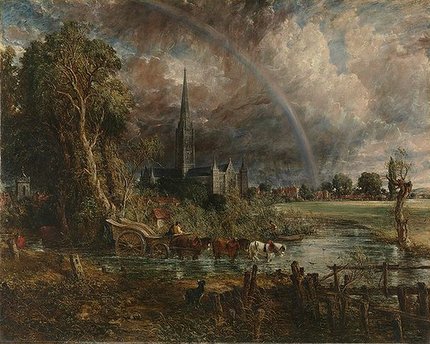
Donde termina el arco iris,
en tu alma o en el horizonte?
—Pablo Neruda
1
Rainbows, in my experience, are infrequent, and so everyone would always go crazy
whenever they saw one. Rainbows were miraculous things and hard to see, and for the
whole time you were looking at it you worried when it would go away. Most important,
though, we wondered where the end of it came down and if there really was a pot of
gold waiting there. Constable’s rainbow is the first thing you see because it
has what rainbows never have, and that’s weight (as heavy as the tree stump or
the tower). It distracts from the rest of the painting.
doesn’t even look real
you know, the stagey way it’s
framed, like scenery, flat
trees obviously painted on
the wagon makes its entrance
a summer shower has passed
and left this bouncing rainbow
in a cauliflower
sky as if some kind of sign
were meant—life’s a ritual
a fence post’s shadow
and the bright chiaroscuro
on the Ash tree’s trunk
those, and the storm clouds passing
make the rainbow possible
2
Constable said: “I mean more than the rainbow itself, I mean dewy light and
freshness, the departing shower, with the exhilaration of the returning sun.”
Even so, when it comes to this painting, Constable criticism cannot sit still. There
is an urgency to translate this work into its symbolic meanings: the passing of
traditional English rural life, the dangers arising from the emancipation of
Catholics, Constable’s grief at the death of his wife, his friendships with
the Bishop of Salisbury and his son, the spirituality of Nature, and even the early
indications of the rise of abstraction in painting.
seems to mean little
to the figures looking on
(I count a dozen)
caught up in their own affairs
not looking at the rainbow
is it still raining
the other side of that rainbow
does the storm now pound
the trees down, flood the gardens
over there, where there’s lightning?
over time the wind
has torn off leaves and branches
stripping the Ash bare
along the side facing us
a tree out of brothers Grimm
3
Only the black and white dog seems to notice the rainbow, but, then, the two of them,
the dog and the rainbow, were late additions. Much more has been said about that
rainbow (perhaps just because it was an afterthought) than about the large hoop-raved
wagon and three horses entering the stream, which like the framing trees, is an image
more carefully wrought than his rainbow was. But, once you’ve seen that little
dog contemplating the whole scene, seeing everything just as you do, just as Constable
must have, but seeing it through a dog’s eyes....
a kind of witness
to the extravaganza
being choreographed
the meeting of heaven and earth
grating where they intersect
while the church tower
fights off the harsh heavens
civilized nature
resists the lightning’s wilding
inviting the wagon in
a view of nature
that’s found in well-trimmed gardens
in plowed, productive
fields, there in the countryside
wild forests kept hemmed in
Bio:
Charles D. Tarlton
